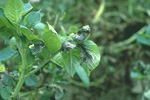Late blight, caused by the plant pathogen Phytophthora infestans, causes a devastating disease of potato and tomato. Over 150 years ago it was responsible for the Irish potato famine. A forensic DNA diagnostic kit for the identification of this pathogen, P. infestans, has been developed in the laboratory of Dr. Jean Ristaino at North Carolina State University and is available from Carolina Biological Supply Company. Use search function to find lab kit). The name of the kit is "Tracking Phytophthora infestans, the Irish Potato Famine pathogen kit." The kit can be used to teach the basics of polymerase chain reaction (PCR) for pathogen diagnosis in plant material and is appropriate for high school, undergraduate and graduate laboratory courses.
With the kit, students will isolate DNA from dried healthy potato leaves and potato leaves infected with P. infestans. Lesions caused by several pathogens can look alike. Thus, the students will then use this DNA to perform PCR to verify that the pathogen in the infected leaf was indeed P. infestans, the pathogen responsible for the Irish Potato Famine. The drying process for the leaves included with this kit kills the pathogen that is present in these leaves, so that it is no longer infectious.
From the modern day perspective, identifying which pathogen has infected a potato or tomato field is not simple and can be critical in determining which fungicide should be used to prevent the crop from being destroyed. You may wish to present this lab to your students as a situation in which a farmer suspects his field could be infected with P. infestans, but needs to have it verified before choosing which fungicide to use on the crop. It is the student's responsibility to run the PCR test for him to determine if the pathogen is indeed P. infestans.
 |
Views: Potato leaves infected by Phytophthora infestans, causal agent of late blight. Note the white sporulation of the pathogen at the lesion edges. |
